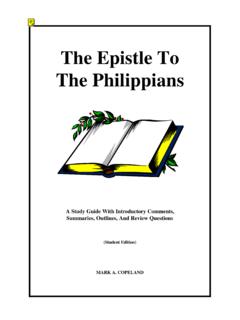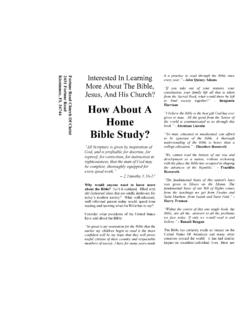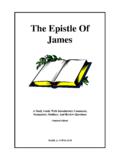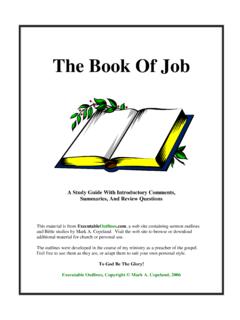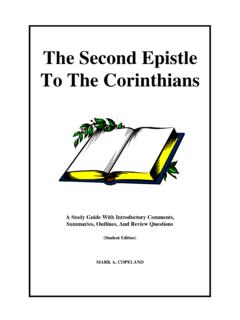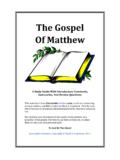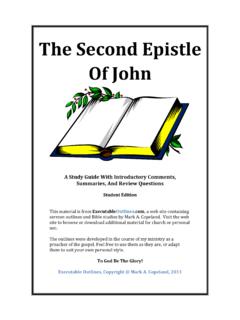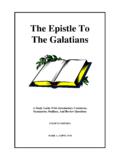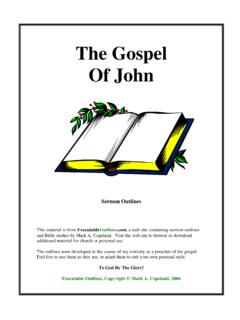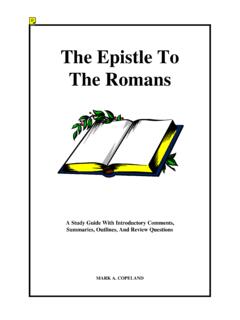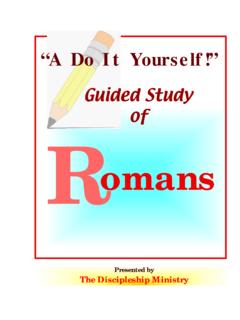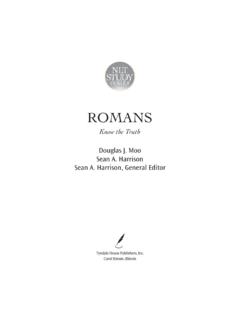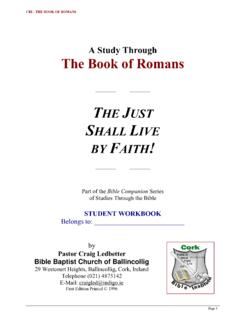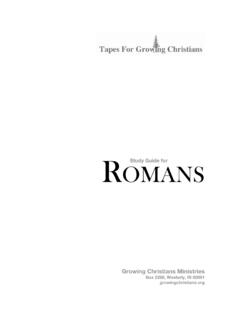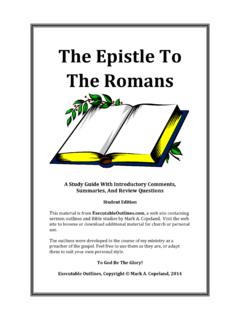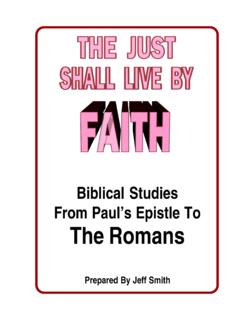Transcription of TheEpistle$To$ TheRomans$ - Executable Outlines
1 The Epistle To The Romans A Study Guide With Introductory Comments, Summaries, And Review Questions Teacher s Edition This material is from , a web site containing sermon Outlines and Bible studies by Mark A. Copeland. Visit the web site to browse or download additional material for church or personal use. The Outlines were developed in the course of my ministry as a preacher of the gospel. Feel free to use them as they are, or adapt them to suit your own personal style. To God Be The Glory! Executable Outlines , Copyright Mark A. Copeland, 2014 2 The Epistle To The Romans Table Of Contents Introduction 3 Chapter One 6 Chapter Two 9 Chapter Three 11 Chapter Four 14 Chapter Five 16 Chapter Six 19 Chapter Seven 21 Chapter Eight 23 Chapter Nine 26 Chapter Ten 29 Chapter Eleven 31 Chapter Twelve 33 Chapter Thirteen 36 Chapter Fourteen 38 Chapter Fifteen 40 Chapter Sixteen 42 This study guide was designed for adult Bible classes.
2 Though it might be suitable for junior and senior high classes as well. Some have used it for personal devotions, and others in small study groups. Points to ponder for each chapter are things I emphasize during the class. Detailed Outlines for each chapter might be useful for sermon or class preparation. Words To Ponder are certain words I think worthy of careful study and reflection. Review questions are intended to reinforce key thoughts in each chapter. That you might know what answers were intended by the questions, I have included them in this guide. There is a student edition available with answers deleted. 3 The Epistle To The Romans Introduction Romans, Paul s greatest work, is placed first among his thirteen epistles in the New Testament.
3 While the four Gospels present the words and works of Jesus Christ, Romans explores the significance of His sacrificial death. Using a question- and- answer format, Paul records the most systematic presentation of doctrine in the Bible. Romans is more than a book of theology; it is also a book of practical exhortation. The good news of Jesus Christ is more than facts to be believed; it is also a life to be lived a life of righteousness befitting the person justified freely by His [God s] grace through the redemption that is in Christ Jesus (Ro 3:24). - Wilkinson, B., & Boa, K. (1983). Talk thru the Bible. Nashville: T. Nelson. In this epistle doctrine and gospel merge, and the result is a spiritual feast for Christians. - Cottrell, J.
4 (1996). Romans (Vol. 1). Joplin, MO: College Press Pub. Co. Author Paul, the apostle (Ro 1:1). The authorship of this epistle has been universally accepted, even by heretical sects who did not like Paul. It is ascribed to Paul by Clement of Rome, Polycarp, Irenaeus, Tertullian, and many other writers in the early church. The internal evidence is also supportive of Paul as its author. Place Of Writing Corinth, as evident from the greetings of Gaius, who lived at Corinth (Ro 16:23; 1Co 1:14), and of Erastus, who had settled down there (Ro 16:23; 2Ti 4:20). Also, Phoebe, who apparently accompanied the epistle (Ro 16:1- 2), was from the church at Cenchrea, a suburb of Corinth. Time Of Writing 57- 58 ; while on his third journey (Ac 20:1- 3), just prior to his arrival to Jerusalem with the collection for the needy saints (Ro 15:25- 26; Ac 20:16; 24:17).
5 Background Of The Church At Rome Nothing is revealed in the New Testament as to the start of the church in Rome. It is possible that visitors to Jerusalem on the day of Pentecost following the Lord s ascension were among the 3000 saved and later took the gospel with them back home (Ac 2:10). Or it could be that among those dispersed following Stephen s death were some that went to Rome and preached the gospel there (Ac 8:1- 4). The first we read of Christians from Rome is possibly that of Aquila and Priscilla, who along with all Jews were expelled from Rome by Claudius and were found by Paul at Corinth during his second journey (Ac 18:1- 2). After travelling with Paul to Ephesus and working with the church there (Ac 18:18- 19, 24- 26; 1Co 16:19), we find them back at Rome and hosting a church in their house (Ro 16:3- 5).
6 From the greetings given by Paul in chapter sixteen, it appears that there were several churches in Rome meeting in various homes (Ro 16:5,14,15). The names of individuals 4 would suggest that the Christians were primarily Gentiles, with a smaller number of Jews. The reputation of the Christians in Rome was widespread; both their faith (Ro 1:8) and obedience (Ro 16:19) were well known. For this reason Paul had long wanted to see them (Ro 15:23), with the goal of sharing in their mutual edification (Ro 1:11- 12) and to be assisted on his way to Spain (Ro 15:22- 24). Purpose Of Writing Paul expresses in this epistle that he had for some time planned to preach the gospel at Rome (Ro 1:13- 15) and from there go on to Spain (Ro 15:22- 24).
7 Though he still had these intentions (Ro 15:28- 29), the spreading cancer of the Judaizing teachers which had disrupted churches in Antioch, Corinth and Galatia was likely to make its way to Rome. To prevent this, and to assure that his visit to Rome would be a pleasant one (Ro 15:30- 33), Paul writes: TO SET STRAIGHT THE DESIGN AND NATURE OF THE GOSPEL In doing so, he demonstrates how the gospel of Christ fulfills what is lacking in both heathenism and Judaism, thereby effectively replacing them as religious systems. Such an epistle would arm the church at Rome against those who would pervert the gospel or suggest that it was inadequate by itself. Theme: Romans 1:16- 17 For I am not ashamed of the gospel of Christ, for it is the power of God to salvation for everyone who believes, for the Jew first and also for the Greek.
8 For in it the righteousness of God is revealed from faith to faith; as it is written, The just shall live by faith. In these two verses Paul states his confidence in the gospel and the reasons for it. The bulk of his epistle is devoted to explaining why and how the gospel of Christ is God s power to save those who believe. outline (adapted from Dextor Sammons) INTRODUCTION (Ro 1:1- 17) I. JUSTIFICATION BY FAITH (Ro 1:18- 11:36) A. SIN - THE NEED FOR SALVATION 1. The need of the Gentiles (Ro 1:18- 2:16) 2. The need of the Jews (Ro 2:17- 3:8) 3. The universal need for salvation (Ro 3:9- 20) B. JUSTIFICATION BY FAITH - THE PROVISION MADE FOR SALVATION 1. God s righteousness through faith (Ro 3:21- 31) 2.
9 Abraham as an example (Ro 4:1- 25) C. FREEDOM - THE RESULT OF SALVATION 1. Freedom from wrath (Ro 5:1- 21) 2. Freedom from sin (Ro 6:1- 23) 3. Freedom from the Law (Ro 7:1- 25) 4. Freedom from death (Ro 8:1- 39) 5 D. JEW AND GENTILE - THE SCOPE OF SALVATION 1. God chooses to save believers (Ro 9:1- 33) 2. Israel chose to trust in their own righteousness (Ro 10:1- 21) 3. Both Jew and Gentile can have salvation through faith (Ro 11:1- 36) II. THE TRANSFORMED LIFE (Ro 12:1- 15:13) A. IN RELATION TO OVERALL CONDUCT (Ro 12:1- 21) B. IN RELATION TO CIVIL AUTHORITY (Ro 13:1- 7) C. IN RELATION TO FELLOW MAN (Ro 13:8- 14) D. IN RELATION TO BRETHREN (Ro 14:1- 15:13) CONCLUDING REMARKS, INSTRUCTIONS, AND BENEDICTION (Ro 15:14- 16:27) Review Questions 1) Who wrote the epistle to the Romans?
10 - The apostle Paul (Ro 1:1) 2) From where was it written? - Corinth 3) What is the approximate date of writing? - 57 or 58 4) What is the purpose of this epistle? - To set straight the design and nature of the gospel 5) Where is the theme of this epistle stated? - Romans 1:16- 17 6 The Epistle To The Romans Chapter One As is the custom in most of his epistles, Paul begins by extending greetings and offering thanks. Identifying himself as a bond- servant of Christ, he mentions his apostleship and its mission in the gospel of God concerning His Son: to bring about the obedience of faith among all the Gentiles (1- 6). Addressing the recipients of his epistle as all who are beloved in Rome, called as saints, he extends to them the popular two- fold greeting of that day: grace and peace (7).

